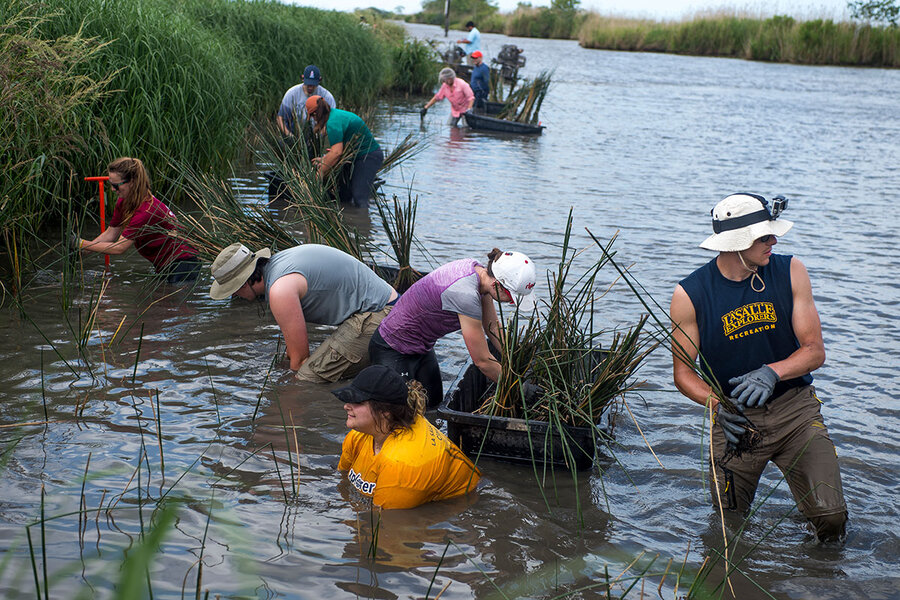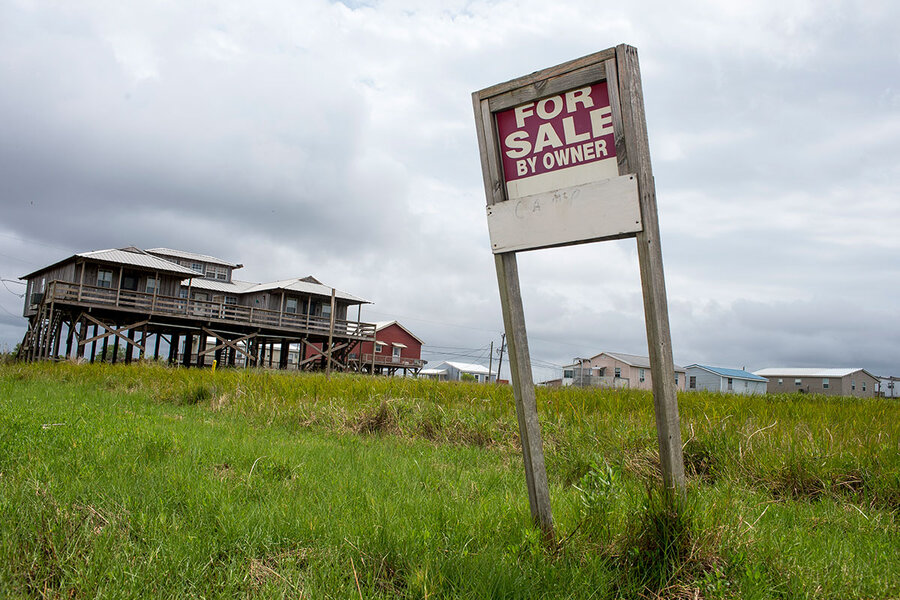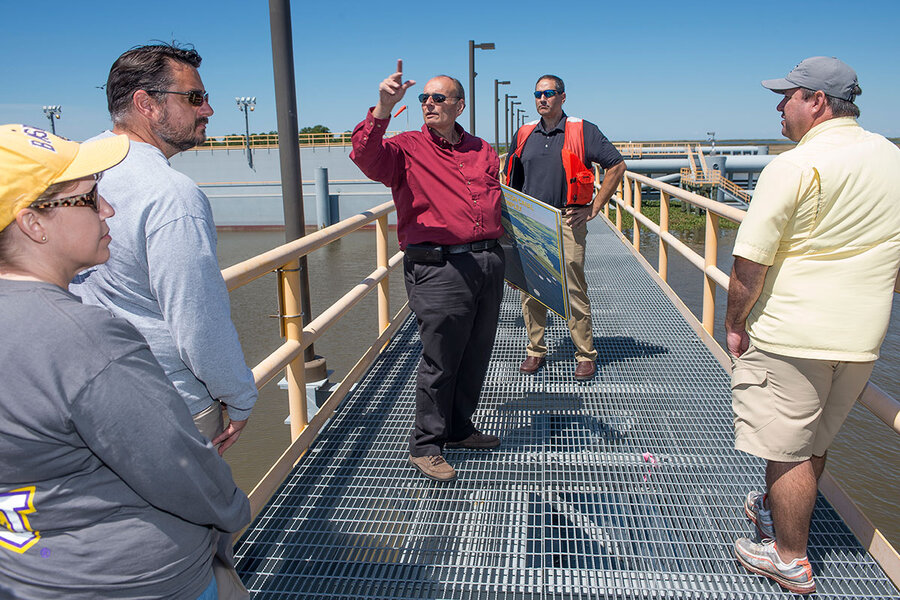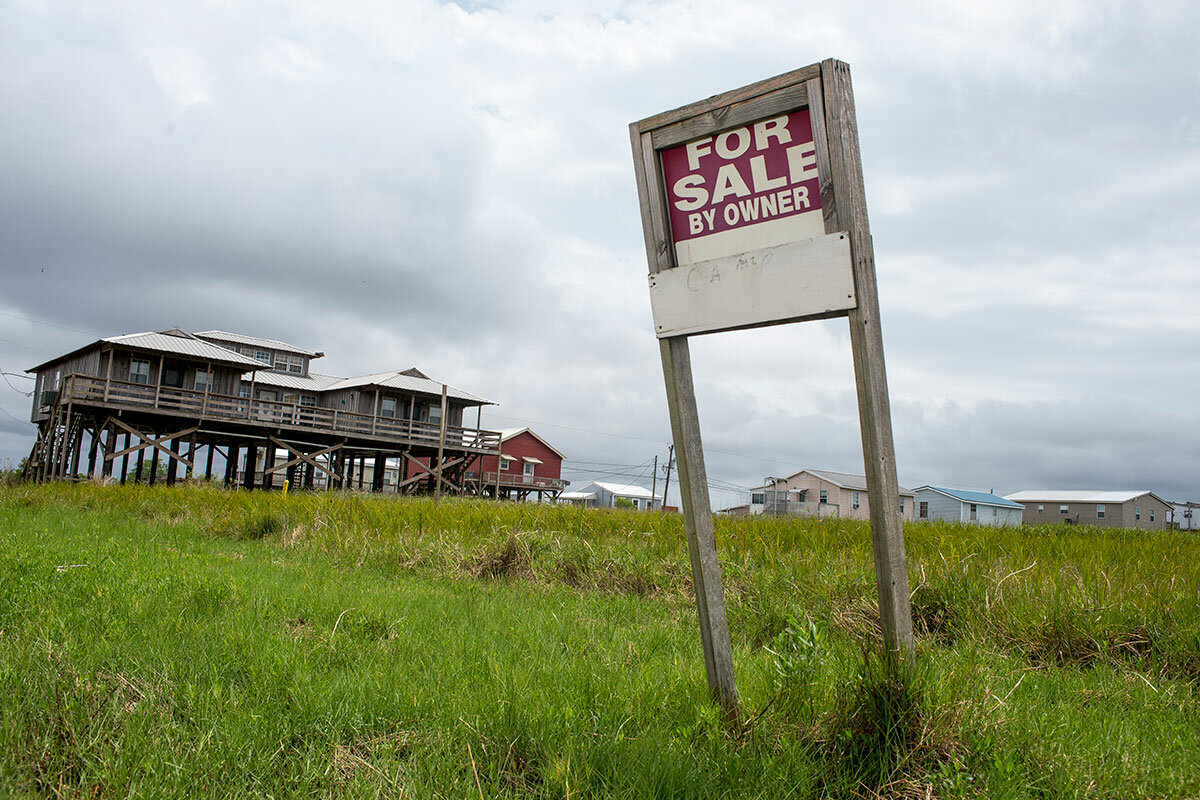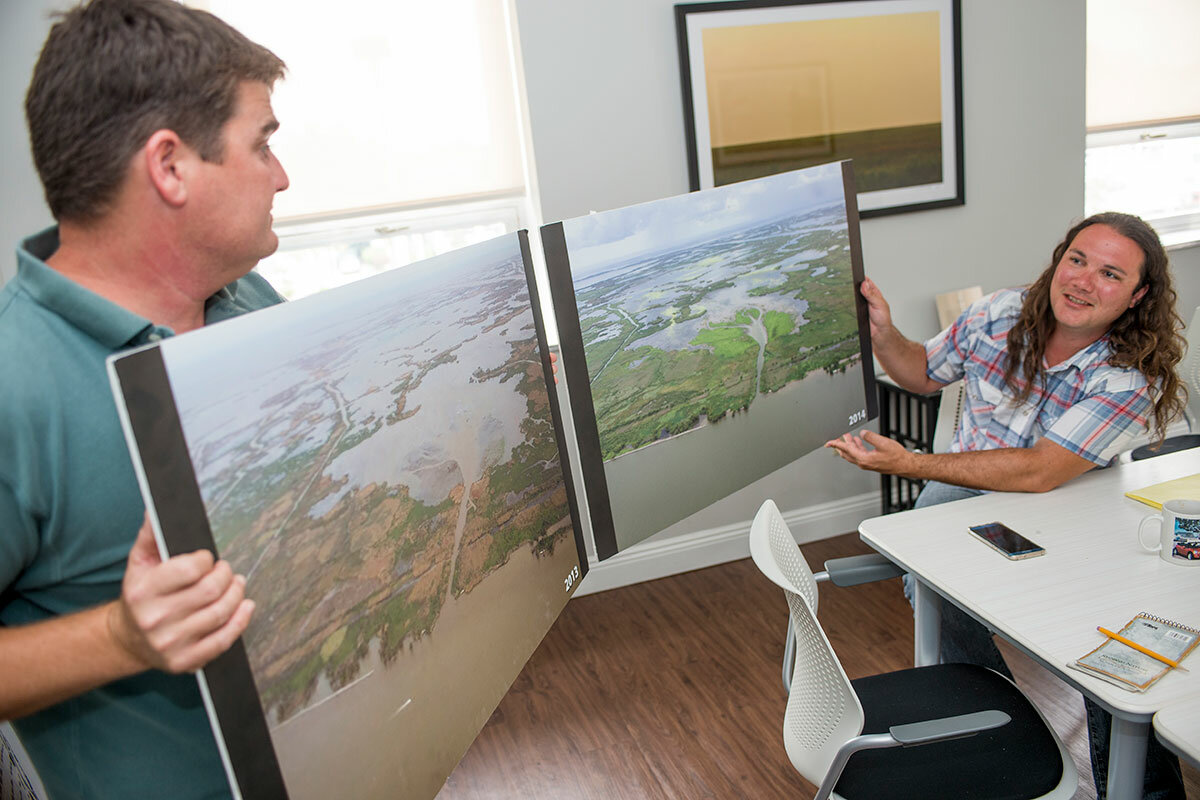In race against rising seas, Louisiana scrambles to save dwindling coast
Loading...
| Jean Lafitte, La.
Tough decisions are coming thicker and faster than the Gulf of Mexico in southern Louisiana these days – and the water is coming up faster than anyone in the region can remember. Stand on the main road in Jean Lafitte, for example, and you can smell the Gulf's salt in the air.
Faced with a multipronged assault of environmental changes combining to wash away the state’s coastline at an unprecedented rate, state officials and local communities are absorbed in nothing less than an existential struggle against an increasingly hostile and proximate ocean.
“The very basic recognition that the coast is in deep trouble and we really need to take action, that’s very widely recognized” in the state, says Torbjörn Törnqvist, chair of the Department of Earth and Environmental Sciences at Tulane University in New Orleans.
Indeed, the science has become hard for Louisiana officials to ignore. The state is losing about a football field of land every hour due to a combination of subsidence, or gradual sinking of land; sea level rise; and a century of human development including levee building and oil and gas exploration that has disrupted the Mississippi Delta’s natural marshland-building processes. The land loss is leaving coastal communities increasingly exposed to storms and flooding events, which are predicted to become even stronger in the future due to climate change.
Louisiana is not the only state facing these issues – Alaska and Virginia, to name two, have their own challenges – but in the absence of broad federal support the Bayou State is arguably making the most concerted effort to deal with them.
The state is 10 years into an ambitious 50-year, $50 billion (and rising) master plan to protect and restore its coastline. The plan, which is reviewed every five years, analyzes the latest scientific research to predict how the coastline may change over the next five decades, then recommends various projects across the state to help protect and mitigate the effects of the changes.
In the most recent iteration of the plan, the best-case estimate for sea level rise almost matches the worst-case estimate for sea level rise in the 2012 plan. It also describes as many as 200 projects in development – including levee construction, barrier island restoration, and diversion of freshwater sediment to gradually rebuild eroding marshland.
But if anything, all the activity has only created more short-term problems and unlocked tougher debates, such as how communities should respond, where money can be scraped from, and where the money should go.
“There’s going to be these local debates among people: what areas get protected; what areas get inundated with fresh water; what areas get protected from future development,” says Robert Verchick, an environmental law professor at Loyola University in New Orleans. “All those things are going to affect individual people, individual families, and individual businesses.”
'A strange blessing in disguise'
In the tight-knit bayou communities of southern Louisiana, all of these debates are inherently personal for local residents. Just ask Reggie Dupre.
Reclining in a leather chair in his office one hot morning in late May, Mr. Dupre – raised in the unincorporated town of Pointe-aux-Chenes – points to a picture of the 2008 Louisiana state Senate, the last time he was a member of the chamber. By that point he was already almost two decades into a political career heavily devoted to coastal issues. Some of his former colleagues, like Steve Scalise and Bill Cassidy, would later rise to national prominence. But Dupre chose to return home to lead the Terrebonne Levee & Conservation District.
He admits that his law degree doesn’t make him much of an expert on civil engineering, but “I was trying to save my population from extinction, that was my ultimate qualification.”
This morning, he is preparing to give a group of community members a bus tour of his pride and joy. That would be the Morganza to the Gulf project, almost 100 miles of levees, floodgates, and other coastal defenses protecting 1,700 square miles of land southwest of New Orleans that he has been working to fund since he was a Terrebonne Parish councilor in the early 1990s.
“My number one priority in public service has been the sustainability and survivability of coastal Louisiana,” he says.
On the bus, he dabs sweat from his forehead, pointing to a levee here, a floodgate there, some dead cypress trees killed by saltwater intrusion. He explains with pride how the entire 35-mile alignment was built without a cent of federal appropriations. (Half of the system was paid for by state master plan funds.)
While Congress authorized the levee system in 1992, and has spent tens of millions of dollars on feasibility studies, it was hesitant to permit and fund construction. After hurricanes Gustav and Ike combined to flood more than 15,000 homes in two weeks, the parish decided it would fund construction itself in partnership with the state.
“It’s sort of a strange blessing in disguise that the federal government never gave us any money,” Dupre says. “It gave us the courage and the ability to start to tax ourselves and start building this on our own. ... We realized the cavalry wasn’t coming.”
But driving back to his office after the tour, Dupre admits that his decades-long efforts to build the system will only bring temporary relief.
“My ancestors arrived in South Louisiana in the 1780s, eight generations ago. We don’t have eight generations in the future,” he says. “What I’m trying to do here is buy another 75, 80 years. What’s going to happen in 150 years? I think this is probably all underwater.”
Unintended consequences
Before the last big flood in Jean Lafitte, Jerry Victoriano thought he’d done everything right. As a lifelong resident of the small town, an hour south of New Orleans, he’d learned to put all the family's valuables high up in the house before they left. His family had become so used to it they joked that evacuations were “e-vacations.”
When they got back the last time, however, his wife opened a bottom drawer and found a scrapbook – pictures of all their children were soaked and ruined.
“She sat down on the bed, took the pictures out, and cried like a baby,” recalls Mr. Victoriano. “She said, ‘Never again, never again.’ ”
Of course, he notes, his wife had said that after the big flood before that one. “We’ve already had two ‘last times,’ ” he says. But next flood, he insists, they won’t be moving back.
Tim Kerner, the town’s mayor since 1991, is close to achieving the modest goal of building a series of six-foot-high tidal levees around the town (thanks to state master plan funding). The development may help preserve the town’s population, at least in the short-term, by keeping residents like Victoriano dry.
But the town is perhaps more prominent as a poster child for one of the chief unintended consequences of the state’s coastal protection efforts.
Over the next decade or so, the state will be spending hundreds of millions of dollars to divert freshwater sediment from the Mississippi River into open saltwater to help rebuild marshlands. While this method of coastal protection takes the longest to implement, it would provide effective and long-lasting coastal protection, engineers say.
Near Jean Lafitte, for example, the state is planning to spend $1.3 billion diverting 30,000 acres of sediment-laden water to build new marshland.
Local fishermen vehemently oppose the diversions, however, because they would alter the salinity regime of the water. The shrimp, fish, and oysters they have spent generations catching in the brackish coastal waters may migrate out of reach for some fishermen.
At Nunez Seafood a few miles south of Jean Lafitte, John Collins – a retired fisherman and oil field worker – says “the cure is as bad as the disease.”
“This is a long-term project, but in the short-term the oyster fishermen are suffering,” he adds, sitting at a table on a hot Friday afternoon in early June. “My opinion is the freshwater diversion is just as bad, or worse, than the erosion.”
A few minutes later, a large red-and-white shrimp boat comes in to dock and begins unloading buckets of white shrimp. Darrel Fricke, the owner, built the 40-foot, $130,000 vessel himself. Thirty-foot boats used to be big enough to shrimp in coastal Louisiana, he says, but now the water is so wide open boats have to be between 50 and 70 feet to withstand the stronger winds and waves. That means ice and fuel expenses are higher, and he’s struggling to break even before he can even think about the damage sediment diversions could bring.
“Freshwater diversion ain’t no good at all,” he says. “In river water, there ain’t nothing but catfish.”
An invasion ignored?
Some observers say Louisiana shouldn’t have to tackle such an immense challenge on its own – particularly given the likelihood that other states will soon be facing similar hurdles. In this respect, the limited role the federal government has played so far is inexcusable, they say.
“If there were a foreign power raiding beaches and threatening people’s towns and villages, we would have a national response,” says Loyola's Professor Verchick. “Hundreds of thousands of people in the next five years are going to be at risk because of climate hazards, yet we have no real federal plan – or even a process of developing a federal plan – to address that.”
He adds: “It’s going to be impossible to address these issues in an efficient, humane, cost-effective way unless we have the federal government developing a unified strategy.”
One map in the 2017 state plan is a color-coded rainbow of areas marked for levee construction, marsh creation, sediment diversion, and other types of projects. The town of Empire is just inside a region marked out as an “area of opportunity” – no large-scale projects have been planned.
Pinched between the Gulf and the Mississippi River, Empire has seen 33 places removed from nautical charts recently – which occurs after a landmark is judged to be "not prominent enough to have any real value," according to the US Coast Guard – and arguably has the fewest opportunities of any coastal community. But Richie Blink, who grew up there watching his “entire world washing away,” is trying to make the “area of opportunity” a reality.
He recently received a $10 million grant to design and build a floating high school, for example. His own high school was destroyed by hurricane Katrina the year after he graduated, but he hopes to design a school on a barge that could be pushed upriver to safety before a storm.
And he’s hoping the next few decades will bring similarly innovative solutions to the daunting challenges the region faces.
“I have a lot of faith in the people [here] that they’re going to come together and figure out how to make these really tough choices, and how to live in a better way,” says Mr. Blink, who works as a local outreach coordinator for the National Wildlife Federation in New Orleans.
“Change is sometimes a really good thing,” he adds. “Just because something’s different doesn’t mean it’s bad. I’m really hopeful we find innovative ways to deal with this.”
This report is the third installment of a four-part series. For the first installment, watch the video below. Click here for Part 2, a look at two towns' very different paths to relocation. And click here for Part 4, a window into one archaeologist's efforts to document Louisiana's coastal history before it washes away.




